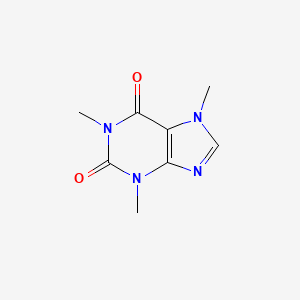D1390 | Caffeine
V
N
R
V04CG30 Caffeine and sodium benzoate
[V04CG] Tests for gastric secretion
[V04C] OTHER DIAGNOSTIC AGENTS
[V04] DIAGNOSTIC AGENTS
[V] Various ATC structures
R03DA20 Combinations of xanthines
[R03DA] Xanthines
[R03D] OTHER SYSTEMIC DRUGS FOR OBSTRUCTIVE AIRWAY DISEASES
[R03] DRUGS FOR OBSTRUCTIVE AIRWAY DISEASES
[R] Respiratory system
N06BC01 Caffeine
[N06BC] Xanthine derivatives
[N06B] PSYCHOSTIMULANTS, AGENTS USED FOR ADHD AND NOOTROPICS
[N06] PSYCHOANALEPTICS
[N] Nervous system
| Toxicity | Dose | Time | Species | Model | Method | Action | Positive criterion | Reference |
|---|---|---|---|---|---|---|---|---|
| OPENING OF PERMEABILITY TRANSITION PORE (PTP) | > 100 µM | 1 hour | Human | HepG2 | High-content screening assay | Negative | MEC | 306 |
| MEMBRANE POTENTIAL | > 400 µM | 30 mins | mouse | liver mitochondria | Rh123 fluorescence (excitation 485 nm, emission 535 nm) are recorded using a fluorescence multi-well plate reader (mCICCP (20 µM) treatments was considered as the 100% baseline for ΔΨm loss) | decrease | EC20 | 36 |
| MEMBRANE POTENTIAL | > 100 µM | 1 hour | Human | HepG2 | High-content screening assay | Negative | MEC | 306 |
| RESPIRATION | > 400 µM | 60 mins | mouse | liver mitochondria | Oxygen consumption was monitored with 50nM MitoXpress ( an oxygen-sensitive phosphorescent dye) using a spectrofluorimeter (Tecan Infinite 200; λExcitation 380nm; λEmission 650nm). Rotenone (2µM) was used as 100% baseline for complex I inhibition. | decrease | EC20 | 36 |
| RESPIRATION | > 400 µM | 60 mins | mouse | liver mitochondria | Oxygen consumption was monitored with 50nM MitoXpress ( an oxygen-sensitive phosphorescent dye) using a spectrofluorimeter (Tecan Infinite 200; λExcitation 380nm; λEmission 650nm). Oligomycin A (1µM) was used as 100% baseline for complex II inhibition. | decrease | EC20 | 36 |
| SWELLING | > 400 µM | 30 mins | mouse | liver mitochondria | swelling assay: Absorbance at 545 nm using a fluorescence multi-well plate reader (CaCl2 (50 µM) was considered as the 100% baseline for the swelling ) | increase | EC20 | 36 |
| ROS PRODUCTION | > 100 µM | 1 hour | Human | HepG2 | High-content screening assay | Negative | MEC | 306 |
| Target | Dose | Time | Species | Model | Method | Action | Positive criterion | Reference |
|---|---|---|---|---|---|---|---|---|
| NADH:ubiquinone reductase | > 400 µM | 60 mins | mouse | liver mitochondria | Oxygen consumption was monitored with 50nM MitoXpress ( an oxygen-sensitive phosphorescent dye) using a spectrofluorimeter (Tecan Infinite 200; λExcitation 380nm; λEmission 650nm). Rotenone (2µM) was used as 100% baseline for complex I inhibition. | inhibit | EC20 | 36 |
| Succinate dehydrogenase | > 400 µM | 60 mins | mouse | liver mitochondria | Oxygen consumption was monitored with 50nM MitoXpress ( an oxygen-sensitive phosphorescent dye) using a spectrofluorimeter (Tecan Infinite 200; λExcitation 380nm; λEmission 650nm). Oligomycin A (1µM) was used as 100% baseline for complex II inhibition. | inhibit | EC20 | 36 |
| Reactive oxygen species | > 100 µM | 1 hour | Human | HepG2 | High-content screening assay | Negative | MEC | 306 |
| Cytochrome c | > 400 µM | 30 mins | mouse | liver mitochondria | Cytochrome c release was evaluated using ELISA kit ( 20 µg/ml Alamethicin was used as 100% baseline) | release | EC20 | 36 |
| Pictogram | Signal | Statements | Precautionary Statement Codes |
|---|---|---|---|
 |
Warning |
H302: Harmful if swallowed [Warning Acute toxicity, oral] |
P264, P270, P301+P312, P330, and P501; (The corresponding statement to each P-code can be found at the GHS Classification page.) |
 |
Warning |
Aggregated GHS information provided by 2331 companies from 7 notifications to the ECHA C&L Inventory. Reported as not meeting GHS hazard criteria by 2 of 2331 companies. For more detailed information, please visit ECHA C&L website Of the 6 notification(s) provided by 2329 of 2331 companies with hazard statement code(s): H302 (99.66%): Harmful if swallowed [Warning Acute toxicity, oral] Information may vary between notifications depending on impurities, additives, and other factors. The percentage value in parenthesis indicates the notified classification ratio from companies that provide hazard codes. Only hazard codes with percentage values above 10% are shown. |
P264, P270, P301+P312, P330, and P501; (The corresponding statement to each P-code can be found at the GHS Classification page.) |
 |
Warning |
H302: Harmful if swallowed [Warning Acute toxicity, oral] |
P264, P270, P301+P312, P330, and P501; (The corresponding statement to each P-code can be found at the GHS Classification page.) |
   |
Danger |
H301: Toxic if swallowed [Danger Acute toxicity, oral] H332: Harmful if inhaled [Warning Acute toxicity, inhalation] H360: May damage fertility or the unborn child [Danger Reproductive toxicity] |
P201, P202, P261, P264, P270, P271, P281, P301+P310, P304+P312, P304+P340, P308+P313, P312, P321, P330, P405, and P501; (The corresponding statement to each P-code can be found at the GHS Classification page.) |

